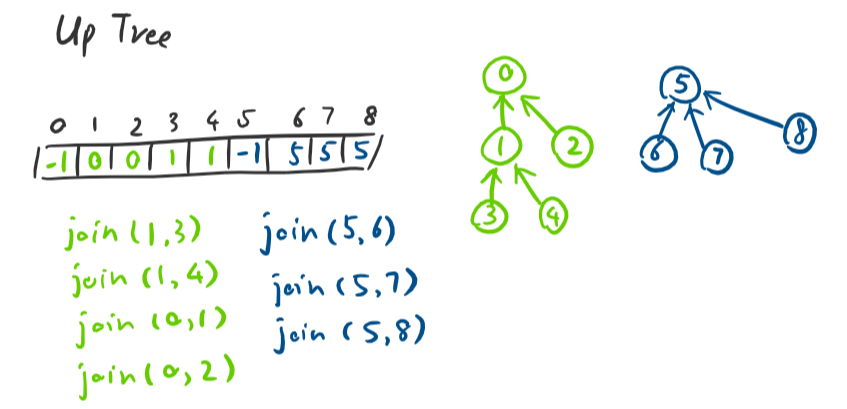Data Structure (7) - Disjoint Sets
Disjoint Sets
Disjoint Sets is the data structure that supports the operation of adding one element (as their own set), [finding the label/canonical_name of one element in a set], and union 2 sets.
It can represents data like:
- Set1 (people whose favorite color's green)
- Set2 (people whose favorite color's blue)
- Set3 (people whose favorite color's red)
- ...
For set S = {S1, S2, S3, ... , Sk}:
- find(Si) where 1<=i<=k, gives representative integer of the set.
e.g. find(Si) = min(S)
- join(Set1, Set2): join 2 sets into one. After this operation, find(Si) where Si was in Set1, will equal to find(Sj) where Sj was in Set2.

Key Ideas
- Each element exists in exactly one set.
- (Elements in sets are not ordered.)
- (If the element is not integer, hash it to integer first.)
- Every set is an equitant representation: 4 belongs to [0]R, 8 belongs to [0]R, then find(4)==find(8) is true (find(4) is 0, and find(8) is 0).
Build
When building disjoint sets:
- Start with everything separated
- Build sets by union the elements
Implementations
Array
Store label of item at array[hash(item)]
- find: O(1)
- union: O(n) – need to go through the array to update labels of one set
Up-Tree
Continue using an array where index is the key. Start all content in array as -1.
The value of array is:
- -1 if we've found the representative element
- The index of parent, if we haven't found the rep.

- find: O(h) where h is the height of the up-tree, and h is only bounded by n (size of the array). So we would like to keep the trees short.
- union: O(1)
Make up-trees faster: instead of storing -1 at roots, store -[number of nodes in tree] and use smart union:
int DisjointSets::find(int i) {
if(arr_[i]<0) return i; // this is the root
else return find(arr_[i]);
}
void DisjointSets::union(int r1, int r2) {
arr_[r1] = r2; // points r1 to r2
}
void DisjointSets::unionBySize(int r1, int r2) {
// union by size: keeps the number of nodes in a tree smaller
int newSize = arr_[r1] + arr_[r2];
if(arr_[r1]<arr_[r2]) { // r1 has more nodes
arr_[r2] = r1; // so only -arr_[r2] nodes gets 1 layer higher
arr_[r1] = newSize;
} else {
arr_[r1] = r2;
arr_[r2] = newSize;
}
}
void DisjointSets::unionByHeight(int r1, int r2) {
// union by height: keeps the height of all trees smaller
if(arr_[r1]< arr_[r2]) { // r1 is heigher
arr_[r2] = r1; // so r1 doesn't get heigher
} else if (arr_[r1]>arr_[r2]) {
arr_[r1] = r2;
} else { // tree gets higher no matter what
arr_[r1] = r2;
arr_[r2] -= 1;
}
}which makes the height of the trees: O(log(n))
Path Compression
int DisjointSets::find(int i) {
if(arr_[i]<0) return i; // this is the root
else {
int root = find(arr_[i]);
arr_[i] = root;
return root;
}
}which makes find O(log(n)) amortized.
If we use both smart union and path compression?
The iterated log function:
log*(n) = {
0 , n<=1
1+log*(log(n)) , n>1
}
e.g. What's lg*(265535)?
1: lg(265535) = 65535,
2: lg(65535) = 16,
3: lg(16) = 4,
4: lg(4) = 2,
5: lg(2) = 1
so lg*(265535) = 5
union_find: O(m*α(n)) or O(α(n)) amortized, where n is number of items in Disjoint Sets. For all practice inputs, it's roughly O(1)
Ref:
- https://courses.engr.illinois.edu/cs225/fa2020/
- https://www.bilibili.com/video/BV1454y127Lk?p=29
